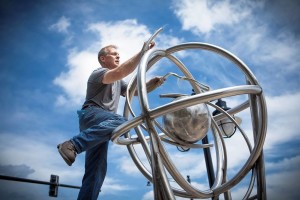Artists are creators. They are always making things, dreaming new ideas, and looking at the world differently. The works of visual artists stand out when displayed on a wall or as sculpture in galleries, museums or First Friday venues. Performance artists are seen throughout the community in theaters, playhouses, concert halls, and small venues including restaurants, bars and private parties. But exhibitions and performances are not the only thing artists create. They are also very good at contributing to placemaking. As Chris Setti, Peoria assistant city manager, states “In modern America, artists have been the vanguard of a lot of urban redevelopment.”

Fisher Stolz, local sculptor and professor at Bradley University, was one of 15 artists selected to have work included in Sculpture Walk Peoria, a project that enhances the Warehouse District streets and the vibrancy of the community. Photo © Dennis Slape
Placemaking is both a process and a philosophy. The term came into use in the 1970s by landscape architects, architects and urban planners to describe the process of creating pleasurable and interesting squares, plazas, parks, streets and waterfronts that will attract people.
Setti says “In the Sculpture Walk and what’s going on in the warehouse district, you can really see the value the artistic community plays in redevelopment. It’s a vibrant area not just because of the artists who have studios there, but because Shelley Lenzini at Rhythm Kitchen has a band come in and play live music or we allow Pat Sullivan to close the street to have the Municipal Band play there on a Wednesday night.”
While the physical reformation of the area is the job of city planners, engineers, architects, and developers, artists are often the ones who begin the process of drawing attention to the potential of a city’s underutilized area. The artists are the first ones to move into an area that has been forgotten and unappreciated. The artists are the ones willing to take the risk of setting up shop or making a home in an area deemed unsuitable by many citizens. And often the artists are the first to leave the area as development begins.
The Murray Building at 100 SW Walnut is where more than 30 artists worked over the last 25 years, benefitting from the patronage of George Murray’s gift of incredibly low cost studio space. Brian Murray, George’ son who has managed the facility since his dad’s passing in 2010, told us that the facility has operated at a loss in order to let artists have affordable studio spaces. It was George’s gift to Peoria, and it did not go unappreciated by the artist community.
Jerry McNeil, a ceramic artist in the Murray building for 13 years, expressed it poetically. “The physical situation has been a tremendous gift, having a third floor perch overlooking the river. My enormous windows and southern exposure have given me warmth, air, and inspiration. And from these windows I’ve witnessed a blossoming, an unfurling as a fern, of the interest and growth in this urban district. All the downtown events, concerts, festivals, holiday celebrations and races, parades, art and people have gone from none-at-all to year-round excitement.”
Now that the Murray Building has been sold to developers for condos, chances are that level of patronage of providing space for artists will never be seen again. But then again it is entirely possible that people interested in maintaining the vibrancy artists create will indeed surface. In fact, one already has. We have been asked to investigate the level of interest for low-cost studio space in the warehouse district. We have withheld the person’s name because we don’t want to commit his interest beyond his capability, but we can say this. His extended family lives in Peoria and we trust his desire to add to the momentum that the arts community has already gained. It is up to the rest of us to continue making Peoria the place where we want to live.

Recent Comments